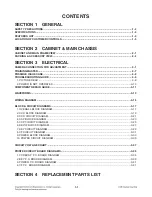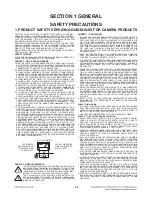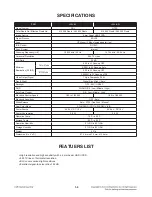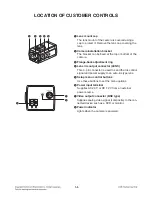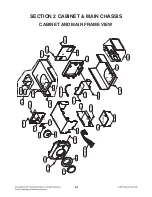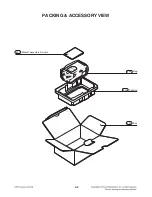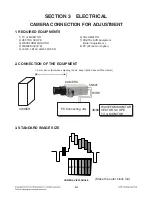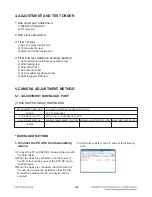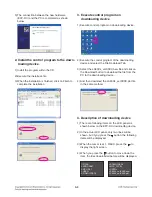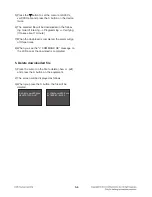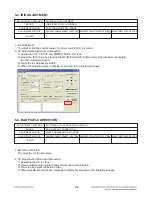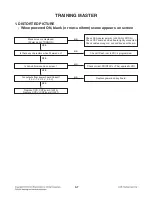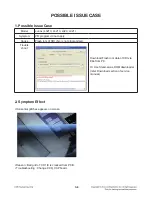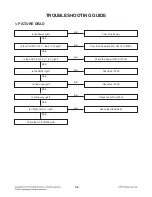
1-3
2. SERVICING PRECAUTIONS
CAUTION : Before servicing the CAMERA covered by this
service data and its supplements and addends, read and
follow the
SAFETY PRECAUTIONS. NOTE : if unforeseen
circumstances create con
fl
ict between the following servic-
ing precautions and any of the safety precautions in this
publications, always follow the safety precautions.
Remembers Safety First:
General Servicing Precautions
1. Always unplug the CAMERA AC power cord from the AC
power source before:
(1)
Removing or reinstalling any component, circuit
board, module, or any other assembly.
(2)
Disconnection or reconnecting any internal electrical
plug or other electrical connection.
(3)
Connecting a test substitute in parallel with an electro-
lytic capacitor.
Caution :
A wrong part substitution or incorrect polar-
ity installation of electrolytic capacitors may result in
an explosion hazard.
2. Do not spray chemicals on or near this CAMERA or any
of its assemblies.
3. Unless speci
fi
ed otherwise in this service data, clean
electrical contacts by applying an appropriate contact
cleaning solution to the contacts with a pipe cleaner, cot-
ton-tipped swab, or comparable soft applicator. Unless
speci
fi
ed otherwise in this service data, lubrication of
contacts is not required.
4. Do not defeat any plug/socket B+ voltage interlocks with
whitch instruments covered by this service manual might
be equipped.
5. Do not apply AC power to this CAMERA and/or any of its
electrical assemblies unless all solid-state device heat
sinks are cerrectly installed.
6. Always connect test instrument ground lead to the ap-
propriate ground before connection the test instrument
positive lead. Always remove the test instrument ground
lead last.
Insulation Checking Procedure
Disconnect the attachment plug from the AC outlet and turn
the power on. Connect an insulation resistance meter(500V)
to the blades of the attachment plug. The insulation re-
sistance between each blade of the attachment plug and
accessible conductive parts (Note 1) should be more than
1Mohm.
Note 1 :
Accessible Conductive Parts including Metal pan-
els, Input terminals, Earphone jacks, etc.
Electrostatically Sensitive (ES) Devices
Some semiconductor (solid state) devices can be damaged
easily by static electricity. Such components commonly are
called Electrostatically Sensitive (ES) Devices. Examples
of typical ES devices are integrated circuits and some
fi
eld
effect transistors and semiconductor chip components.
The following techniques should be used to help reduce the
incidence of component damage caused by static electricity.
1. Immediately before handling any semiconductor compo-
nent or semiconductor-equipped assembly, drain off any
electrostatic charge on your body by touching a known
earth ground. Alternatively, obtain and wear a com-
mercially available discharging wrist strap device, which
should be removed for potential shock reasons prior to
applying power to the unit under test.
2. After removing an electrical assembly equipped with ES
devices, place the assembly on a conductive surface
such as aluminum foil, to prevent electrostatic charge
buildup or exposure of the assembly.
3. Use only a grouned-tip soldering iron to solder or unsol-
der ES devices.
4. Use only an anti-static solder removal device. Some sol-
der removal devices not classi
fi
ed a “anti-static” can gen-
erate electrical charges suf
fi
cient to damage ES devices.
5. Do not use freon-propelled chemicals. These can gener-
ate electrical charge suf
fi
cient to damage ES devices.
6. Do not remove a replacement ES device from its protec
tive package until immediately before you are ready to in-
stall it. (Most replacement ES devices are packaged with
leads electrically shorted together by conductive foam,
aluminum foil, or comparable conductive material).
7. Immediately before removing the protective material from
the leads of a replacement ES device, touch the protec-
tive material to the chassis or circuit assembly into which
the device will be installed.
Caution : Be sure no power is applied to the chassis or
circuit, and observe all other safety precautions.
8. Minimize bodily motions when handling unpackaged
replacement ES devices. (Normally harmless motion such
as the brushing together of your clothes fabric or the lift-
ing of your foot from a carpeted
fl
oor can generate static
electricity suf
fi
cient to damage an ES device.)
Summary of Contents for L320-BN
Page 7: ...1 6 ...
Page 9: ...2 2 801 Manual Assembly Owners 804 Bag 803 Packing 802 Box PACKING ACCESSORY VIEW ...
Page 21: ...3 12 ...
Page 37: ...3 43 3 44 ...


